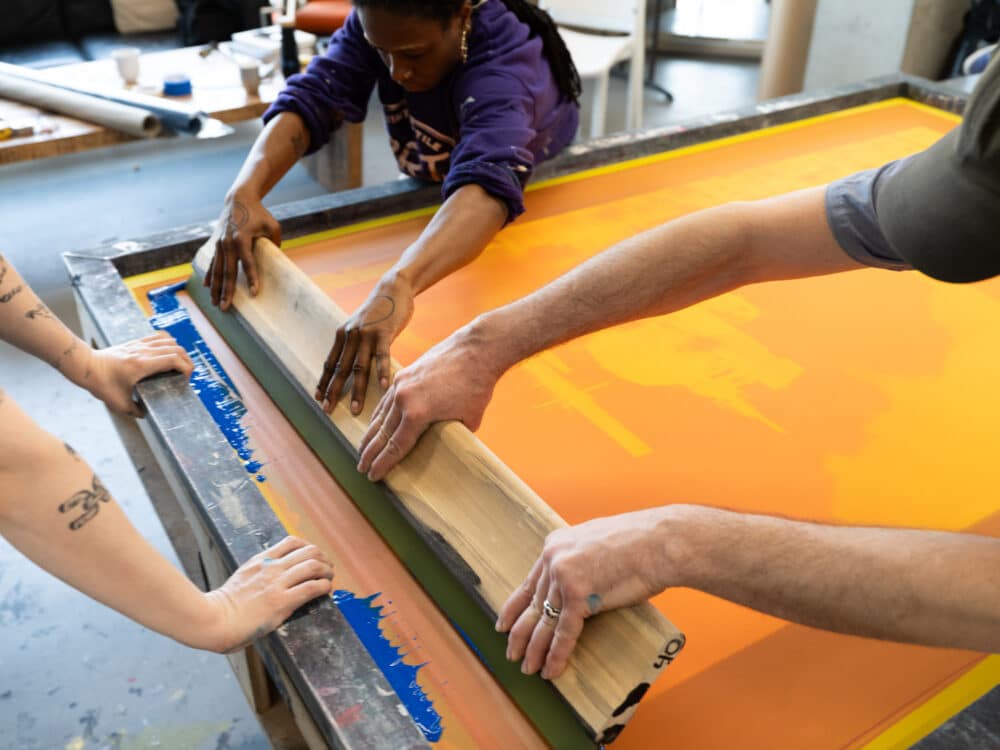The Important Guide to Recognizing Screen Printing and Its Versatile Utilizes
Screen printing has an abundant history that dates back to ancient times, progressing right into a sophisticated technique used throughout numerous industries today. This guide discovers the details of the screen printing procedure, outlining its applications in style, home, and advertising and marketing décor - 10:9 Design Embroidery. Recognizing these fundamentals can open innovative possibility for both industrial and creative jobs. The complying with areas will reveal important tips and techniques to boost one's screen printing undertakings
The Background of Screen Printing
Screen printing has origins that map back centuries, its advancement reflects the technological and imaginative advancements of numerous societies. Coming from in old China, the strategy was originally used for enhancing fabrics and later infect Japan, where it became essential to Ukiyo-e woodblock printing. The technique shifted to Europe in the 18th century, where it obtained popularity amongst craftsmens and commercial printers. The innovation of image solution in the 20th century revolutionized screen printing, allowing for even more elaborate layouts and greater effectiveness. Artists like Andy Warhol even more moved its appeal, making use of the medium to create renowned jobs that combined commercialism and fine art. By the late 20th century, screen printing had actually established itself as a flexible method, used in vogue, marketing, and art. Today, it continues to evolve, integrating digital modern technology and broadening its applications across different industries.
The Screen Printing Refine Explained
Screen printing transforms imaginative visions right into concrete layouts with a series of specific actions. A photo is produced and then moved onto a screen, generally made of fine mesh material stretched over a frame. A light-sensitive solution is put on the screen, which is subjected to light, solidifying in locations not covered by the picture. After rinsing the unhardened emulsion, a pattern is developed.
Next off, the screen is positioned over the substratum, whether it be textile, paper, or an additional material. Ink is after that pressed via the open areas of the stencil making use of a squeegee, transferring the layout onto the substratum below. This procedure can be duplicated for numerous colors, needing different displays for each hue. Finally, the published item is healed using heat to ensure the ink adheres correctly, leading to a resilient, vibrant style on-line.
Kinds Of Screen Printing Techniques

In addition, specialty methods, such as discharge screen printing, eliminate dye from the material to develop softer prints, while foil screen printing applies metal aluminum foil to achieve a glossy finish (10:9 Design contact). Each strategy supplies distinct attributes, catering to different innovative needs and manufacturing ranges, ultimately increasing the possibilities within the screen printing domain name
Applications of Screen Printing in Different Industries

Furthermore, the signs and advertising and marketing markets utilize screen printing for developing appealing screens and banners. This approach enables vibrant colors and intricate layouts that record focus. In electronic devices, screen printing is utilized for using conductive inks to circuit card, important for component connections. Moreover, the home décor industry accepts screen printing to generate unique designs on fabrics and wall art. In general, screen printing acts as a critical tool across diverse fields, boosting items with personalized and visually attractive graphics.
Tips for Successful Screen Printing Projects
While embarking on a screen printing project, cautious interest to information can substantially boost the final end result. First, selecting top quality materials is important; this consists of the screen, inks, and substratums. Making use of appropriate mesh matters can impact ink deposition and detail resolution. Preparation is just as crucial; comprehensive cleansing of displays and correct exposure times guarantee crisp prints.
Next off, accurate enrollment is vital for multi-color prints. Using alignment tools can aid achieve precise layering. Furthermore, screening prints on scrap materials prior to production assists identify prospective issues without wasting sources.

Frequently Asked Questions
What Materials Are Ideal for Screen Printing on Fabric?
Cotton and polyester blends are perfect for screen printing on material due to their durability and ink absorption. Additionally, specialized textiles like silk or canvas can generate special appearances and finishes, boosting the total design top quality.
How Do I Tidy and Maintain Screen Printing Equipment?
To clean and maintain screen printing tools, one must consistently wash screens with proper solvents, check squeegees for wear, oil relocating parts, and shop all things in a completely dry, dust-free environment to extend their life expectancy.
What Are the Ecological Impacts of Screen Printing?
Screen printing can have considerable ecological effects, including chemical waste from inks and solvents, water use during cleansing processes, and power consumption. Eco-friendly materials and lasting methods are vital for lessening these unfavorable effects.
Can Screen Printing Be Done in your home Efficiently?
Screen printing can be properly done at home with the ideal materials and strategies. Enthusiasts can develop high quality prints, though success depends upon their skill degree, equipment, and understanding of the procedure included.
What Are the Prices Linked With Beginning a Display Printing Business?

Beginning a screen printing business entails prices for devices, products, and work area. Initial expenditures generally range from a couple of more info hundred to a number of thousand bucks, depending upon the range, quality of machinery, and desired manufacturing capability.
Screen printing has a rich background that dates back to old times, developing into an advanced technique used throughout various markets today. An additional technique, rotary screen printing, utilizes round displays, assisting in constant printing on fabric rolls, therefore enhancing effectiveness for massive manufacturings. Furthermore, specialty methods, such as discharge screen printing, eliminate dye from the material to produce softer prints, while foil screen printing applies metallic aluminum foil to attain a glossy coating. In the style field, screen printing is commonly utilized to produce vibrant styles on clothing, allowing brands to display their one-of-a-kind styles. Cotton and polyester blends are perfect for screen printing on material due to their longevity and ink absorption.